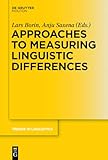Approaches to Measuring Linguistic Differences / ed. by Anju Saxena, Lars Borin.
Material type: TextSeries: Trends in Linguistics. Studies and Monographs [TiLSM] ; 265Publisher: Berlin ; Boston : De Gruyter Mouton, [2013]Copyright date: ©2013Description: 1 online resource (545 p.)Content type:
TextSeries: Trends in Linguistics. Studies and Monographs [TiLSM] ; 265Publisher: Berlin ; Boston : De Gruyter Mouton, [2013]Copyright date: ©2013Description: 1 online resource (545 p.)Content type: - 9783110303759
- 9783110305258
- 400
- online - DeGruyter
- Issued also in print.
| Item type | Current library | Call number | URL | Status | Notes | Barcode | |
|---|---|---|---|---|---|---|---|
 eBook
eBook
|
Biblioteca "Angelicum" Pont. Univ. S.Tommaso d'Aquino Nuvola online | online - DeGruyter (Browse shelf(Opens below)) | Online access | Not for loan (Accesso limitato) | Accesso per gli utenti autorizzati / Access for authorized users | (dgr)9783110305258 |
Frontmatter -- Preface -- Contents -- Introduction -- The why and how of measuring linguistic differences -- Case studies -- Contrasting linguistics and archaeology in the matrix model: GIS and cluster analysis of the Arawakan languages -- Predicting language-learning difficulty -- How aberrant are divergent Indo-European subgroups? -- Measuring socially motivated pronunciation differences -- Distance-based phylogenetic inference algorithms in the subgrouping of Dravidian languages -- Carving Tibeto-Kanauri by its joints: Using basic vocabulary lists for genetic grouping of languages -- The effect of linguistic distance across Indo-European mother tongues on learning Dutch as a second language -- Using semantically restricted word-lists to investigate relationships among Athapaskan languages -- Languages with longer words have more lexical change -- Methods and tools -- The Intercontinental Dictionary Series – a rich and principled database for language comparison -- Towards automated language classification: A clustering approach -- Dependency-sensitive typological distance -- Degrees of semantic control in measuring aggregated lexical distances -- Word similarity, cognation, and translational equivalence -- Comparing linguistic systems of categorisation -- Black box approaches to genealogical classification and their shortcomings -- Semantic typologies by means of network analysis of bilingual dictionaries -- Measuring morphosemantic language distance in parallel texts -- Information-theoretic modeling of etymological sound change -- Index
restricted access online access with authorization star
http://purl.org/coar/access_right/c_16ec
The present volume collects contributions addressing different aspects of the measurement of linguistic differences, a topic which probably is as old as language itself but at the same time has acquired renewed interest over the last decade or so, reflecting a rapid development of data-intensive computing in all fields of research, including linguistics.
Issued also in print.
Mode of access: Internet via World Wide Web.
In English.
Description based on online resource; title from PDF title page (publisher's Web site, viewed 25. Jun 2024)


